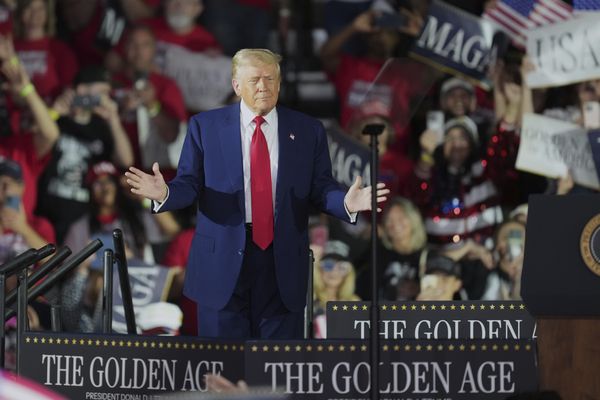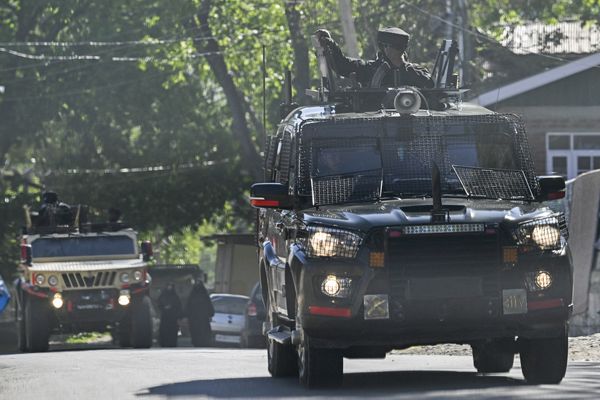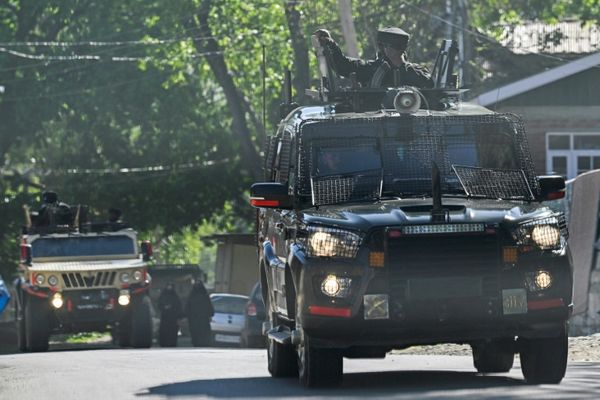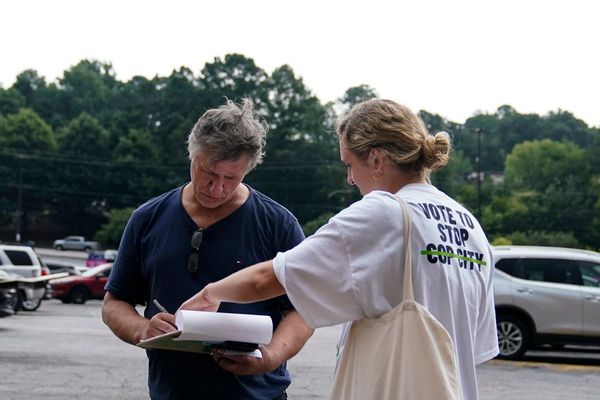
The enthralling Cornelia Parker survey now open at Tate Britain is about 20 years overdue – but far better late than never. At 65, with her poetic and highly original imagination, Parker has made enough masterpieces to fill a full-scale retrospective and even spill out into the surrounding galleries.
The show opens with the radiant Thirty Pieces of Silver, hanging spotlit in darkness. Thirty flattened settings, each made of 30 pieces of Edwardian silver, each teapot, plate and cake fork now resembling the charm in some nostalgic Christmas pudding. Everything is hanging by a thread, only inches from the ground, bright emblems of a Downton grandeur in freefall.
Cold Dark Matter: An Exploded View – the equally archetypal potting shed specially blown to smithereens by the British army – appears midway through, its galaxy of fragments perpetually frozen in mid-air. The old Thermos, the Bakelite clock, a hand-me-down pram, perished wellies: everything in its never-ending explosion is so redolent of an England that is forever passing but never quite gone. And the whole spectacular period piece, repeated in drifting shadows on the walls, alludes to explosions of all kinds: astral, accidental, human-made. Nobody looking at it now, with its shards of washing machine and window, could fail to think of the Russian bombing of Mariupol.

Parker’s art spreads out into the museum. A handkerchief bearing tarnish from Charles I’s spurs, which she has painstakingly cleaned, forms the strangest of stains, somewhere between portrait and history by other means. The old canvas linings of paintings by Turner, framed on the wall in the Turner galleries, now look like eerie Rothkos. And greeting you on arrival in the Manton foyer is Parker’s marvellous swathing of Rodin’s The Kiss with a mile of string.
The lovers’ faces are now shrouded, like the figures in Magritte’s deadly painting of a couple trying to kiss through cloth, and their marble embrace turns deeply ambiguous. Is this blind love, an allusion to Dante’s Paolo and Francesca, doomed never quite to meet (Rodin’s source), or do you see a couple fatally bound together?

Parker’s is an art of translation, transformation, redemption. She makes something from nothing, and the new from the old; turns the barely material into a poetry of objects.
A bullet melted down and spun into a fine thread is used to make the most refined of drawings, evocative of crosshairs and the graphite abstractions of the American artist Agnes Martin. The cracks between paving slabs in London’s Bunhill Fields, where Daniel Defoe and William Blake are buried, are cast into a bronze tracery that hangs just above the ground like the leading of an old grave, or the grid of a minimalist sculpture. Marks left by workmen pointing the perimeter walls of Pentonville prison, attentively noticed and photographed by Parker, look like the monochrome abstractions of Robert Motherwell.
Parker’s own terms for what she makes cannot be bettered. Sculptural Negatives, for instance, are exactly as they sound. The residue collected by a silversmith from his hand-engraved inscriptions becomes a small shining heap, instantly evocative of unspoken words. The cutting of tracks into a black lacquer disc, performed at Abbey Road Studios, produces fine coils of lacquer that Parker tangles into vibrating sound clouds.

Some of the show amounts to a crime museum turned inside out. A murderer’s gun is reduced to a pile of rust-red dust: its own deadly remains. Photographs of glowering clouds turn out to have been taken by the artist using a camera that once belonged to Rudolph Höss, camp commandant at Auschwitz. An Oliver Twist doll, one eye shut, the other open, the mouth a comical cakehole, so to speak, has been chopped in two by the very guillotine used to decapitate Marie Antoinette.
To look through the same lens as a mass-murdering Nazi must surely mean more to Parker than it ever could to us; my sense is that the resulting images can never hold quite the same significance either. And meaning is vital to this art of metaphor, evocation and allusion. A series of Rorschach prints have been created using rattlesnake venom and its antidote mixed with black and white ink. Parker commissioned these substances from local farmers and pharmacists during a residency in Texas. But you need to know this for the prints to hold any potency, which is nothing less than the power to kill or indeed save you.
Parker always leaves space for argument; there is nothing autocratic here. The hand-stitched backs of old button cards, revealing the labour of long-ago women, make beautiful abstract drawings; but they are only photographs, not the actual artefacts themselves. Hasn’t the human touch been erased? Blackboards covered in tabloid headlines chalked up by primary school children play upon their innocent ignorance of what it is they reproduce; but should that innocence be played upon? And what does it actually mean to take a sawn-off shotgun and saw it up again into particles? Take a disputatious friend if you’re visiting this show.

The later the work, the more political and elegiac. A terrific group of films includes her drone footage of a deserted House of Commons, suddenly very small, haunted by newspapers that gradually flutter into life as if trying to speak to the absent MPs. Her study of the making of Remembrance Day poppies notes the astonishing analogies between the red belts of paper, shunted and drilled through the machines, and the great mounding heap of discarded matter, tossed aside like fallen soldiers. Parker has a poet’s eye for every detail that might count.
Most affecting of all is a film portrait of a Palestinian Muslim who has been making crowns of thorns for 40 years, providing a service for Christian pilgrims to Bethlehem. The film is subtle and capacious, so that one learns the process while pondering the strange ritual by which people imitate Christ’s suffering. His calloused hands manipulate the barbs with ease, but his heart is not hardened. All he wants is a halfway decent airport for better trade, and peace in the Middle East.
The exhibition is superbly arranged so that the works speak back and forth to each other all the time – grid to grid, Rorschach to Rorschach, shed to shed. The missing buttons echo the faceless medals that show only the backs of political heads (Bush and Blair, made during the Iraq war). The flattened silver returns with the flattened instruments in Perpetual Canon, their dangling shadows drifting round the walls.

The sense of a mind unfolding expands into the wall texts, which were written by Parker herself. They amount to an additional medium. It is not just that they offer a crucial backstory of her methods – scorching, flattening, stretching, shooting, spilling, dropping – but that they add words as another form of art.
The final work at Tate Britain was made in 2022. It takes her approach to words, objects and meanings about as far as it can go. A greenhouse stands alone in a shadowy gallery, its overhead bulb (think of the potting shed) coming and going in the rhythms of an anxious human breath. Its glass is marked all over with chalk dabs, made using chunks of the white cliffs of Dover. Nothing is growing. All you can see are the ecclesiastical-looking salvaged tiles from Pugin’s House of Commons lining the floor. A little England, encamped, enclosed and empty, cut off from Europe in the one-word poem of Parker’s title – Island.
Cornelia Parker is at Tate Britain, London, until 16 October







